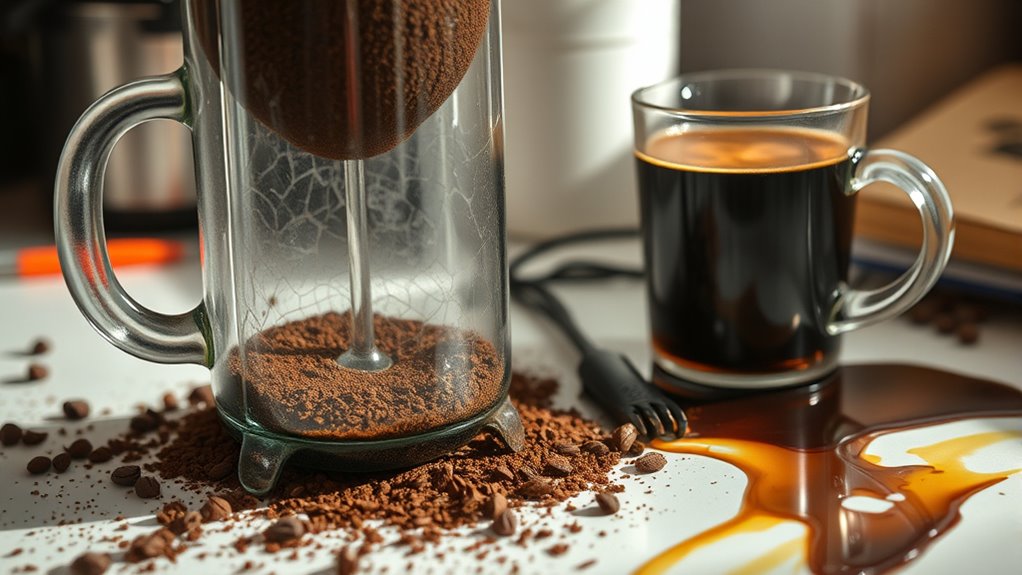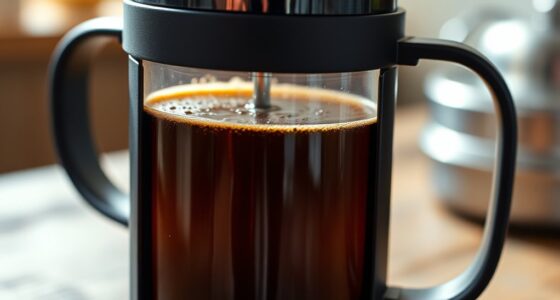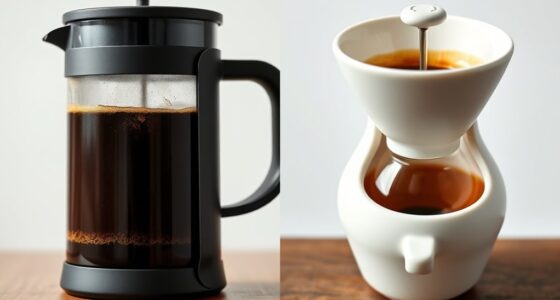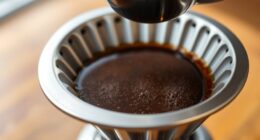One common mistake is using grounds that are too fine, which can cause sediment and bitterness. Make sure your grind resembles breadcrumbs to prevent over-extraction. Also, avoid pouring boiling water directly into a cold French press—instead, preheat it first. Be mindful of steeping time; over 4 minutes can make your coffee bitter. Properly removing grounds and cleaning your equipment are essential to prevent muddy flavors. Keep these tips in mind to improve your brew and discover more secrets for perfect coffee.
Key Takeaways
- Using overly fine grounds can cause sediment and over-extraction, leading to bitter flavors.
- Not preheating the French press or adding boiling water can scorch grounds and affect flavor.
- Steeping coffee for more than 4 minutes results in over-extraction and a muddy taste.
- Leaving grounds in the brew or delaying transfer causes bitterness and muddiness.
- Using a damaged or low-quality plunger allows grounds to slip through, compromising clarity.

Using a French press is a straightforward way to brew rich, flavorful coffee, but common mistakes can ruin the experience. One of the most vital factors is selecting the right grind size for your coffee grounds. If you grind your beans too finely, the particles can slip through the mesh filter and create sediment in your cup, giving it a gritty texture. More importantly, a grind that’s too fine leads to over-extraction during brewing, which pulls out bitter compounds and results in an unpleasant, muddy flavor. To avoid this, opt for a coarse grind—similar to breadcrumbs—that allows water to flow evenly through the grounds without over-extracting.
Use a coarse, breadcrumb-like grind to prevent sediment and over-extraction in your French press.
Temperature is another key element often overlooked. Pouring boiling water directly into a cold French press can scorch the coffee grounds, imparting a burnt taste that spoils your brew. Instead, preheat your French press and cups with hot water first, then discard the warming water before adding your freshly boiled water. This step guarantees the brewing temperature stays consistent, typically around 195-205°F, which is ideal for extracting the best flavors from your coffee beans.
Timing is just as critical. Leaving the coffee in the press after the brewing time is up causes over-extraction, leading to a bitter and muddled cup. Once your timer hits the recommended 4 minutes, press the plunger down gently and serve immediately. Waiting longer allows the grounds to continue steeping, pulling out unwanted bitter compounds and diminishing the fresh, vibrant flavor you’re aiming for.
Another common mistake is neglecting to remove the grounds promptly after brewing. If you leave the coffee sitting in the French press, extraction continues, resulting in a muddy, overly bitter brew. To maintain the integrity of your coffee’s flavor, transfer it to a separate container or pour into cups right after pressing. This prevents residual extraction and keeps your coffee tasting clean and bright.
Finally, avoid using a damaged or improperly functioning plunger. A sturdy plunger with a fine mesh filter ensures that grounds stay separated from your liquid, reducing sediment and enhancing clarity. Regularly clean your French press thoroughly to prevent old coffee oils and grounds from building up, which can interfere with flavor and cause clogging. Additionally, be mindful that the filter system plays a crucial role in preventing grounds from slipping through and spoiling your brew.
Frequently Asked Questions
What Not to Do With a French Press?
When using a French press, don’t use a fine or uneven grind, as it’ll cause over-extraction and sediment.
Never pour boiling water into a cold press, and avoid leaving your coffee sitting too long, which makes it bitter.
Always preheat your equipment, skip dark roasts or long brew times that can result in burnt or weak coffee.
Keep these tips in mind to brew a perfect cup every time.
What Is Unhealthy About French Press Coffee?
You might find French press coffee unhealthy because it can contain higher levels of cafestol and kahweol, which raise your LDL cholesterol if you drink it often. The metal filter doesn’t remove these oils effectively.
Plus, drinking very hot coffee can burn your mouth or damage your esophagus.
If you don’t clean your French press well, bacteria can grow, posing health risks.
Be mindful of these issues to enjoy coffee safely.
How to Use a French Press Perfectly?
To use a French press perfectly, start by preheating it and your mug with hot water.
Use a coarse grind, roughly sea salt size, to avoid sediment.
Measure coffee and water accurately at a 1:12 ratio, then pour water that’s just off boiling, around 202°F.
Stir gently, set a timer for four minutes, and press down smoothly.
Immediately pour your coffee to prevent over-extraction and bitterness.
Why Is My French Press Coffee so Bad?
If your French press coffee tastes bad, you might be making some simple mistakes. Maybe your grind is too fine, causing over-extraction and bitterness, or you’re not using the right water temperature, which can burn the grounds.
Also, leaving the coffee in the press too long or using improper measurements can ruin the flavor.
Try adjusting these factors to improve your brew and enjoy a better-tasting cup.
Conclusion
To make the perfect French press coffee, avoid these common mistakes. Pay attention to grind size, water temperature, and steeping time. Don’t rush the process or forget to stir before pressing. Keep your equipment clean, and use fresh beans for the best flavor. With a little care and attention, you’ll enjoy rich, smooth coffee every time. Just remember these tips, and you’ll master your French press brewing game effortlessly.









